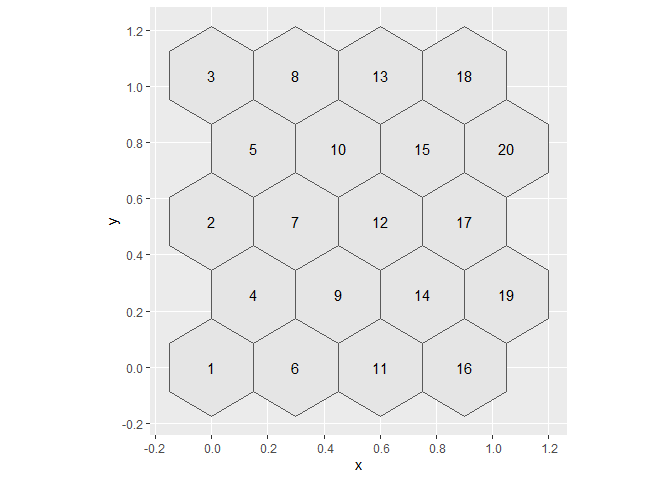我想“细化”用 sf::st_make_grid 制作的网格并获得高阶邻居的子集。
一阶邻居至少共享一侧,二阶邻居与一阶邻居共享一侧,依此类推。
这是一个例子:
require(sf)
require(ggplot2)
x = st_sfc(st_polygon(list(rbind(c(0,0), c(1,0), c(1,1), c(0,0)))))
g = st_make_grid(x, cellsize = .3, square = FALSE )
g = st_as_sf(g)
g$id = 1:nrow(g)
ggplot(g) + geom_sf() + geom_sf_text(aes(label = id))
二阶邻居的可能子集将是:
gs = g[g$id %in% c(3:5, 11:12, 18:20),]
ggplot(gs) + geom_sf() + geom_sf_text(aes(label = id))
但其他示例也是可能的,例如c(1,2,9,8,10,16,17)
如何子集到任何更高阶的邻居?
最佳答案
我会尝试按如下方式解决您的问题。只是一个“免责声明”:我不确定以下方法是否 100% 正确并且它在所有情况下都有效。而且,正如前面评论中所讨论的,以下解决方案不是唯一的,您可以根据算法背后的出发点和选择得到不同的“细化”。
加载包
# packages
library(sf)
library(igraph)
library(ggplot2)
生成数据并绘制所有多边形
x = st_sfc(st_polygon(list(rbind(c(0,0), c(1,0), c(1,1), c(0, 1), c(0,0)))))
g = st_make_grid(x, cellsize = .3, square = FALSE)
g = st_as_sf(g)
g$id = 1:nrow(g)
# plot all polygons
ggplot(g) +
geom_sf() +
geom_sf_text(aes(label = id))

提取单元格背后的图形结构,并将其绘制出来
my_graph <- graph_from_adj_list(st_touches(g))
plot(my_graph)

您可以注意到它或多或少与以前相同,没有任何地理结构。如果将相同的代码应用于“现实世界问题”,则可能需要使用不同的空间谓词并调整 sf 对象的精度,因为坐标中可能存在舍入误差。
现在,从第一个单元格开始计算一阶邻居列表(应排除)
id_to_be_ignored <- ego(my_graph, order = 1, nodes = 1)[[1]]
以及一阶和二阶邻居列表
all_second_order_neighbours <- ego(my_graph, order = 2, nodes = 1)[[1]]
最终示例应包含这两个 id 之间的差异
final_sample <- difference(all_second_order_neighbours, id_to_be_ignored)
现在我需要对二阶单元重复此操作
i <- 1
while (TRUE) {
# We need to end the loop sooner or later
if (i > length(final_sample)) break
# Extract the id of the node
id <- final_sample[[i]]
# Determine and exclude first order neighbours considering the id-th node
ego1_id <- ego(my_graph, order = 1, nodes = id)[[1]]
id_to_be_ignored <- union(id_to_be_ignored, difference(ego1_id, V(my_graph)[id]))
# Determine and add second order neighbours considering the id-th node
ego2_id <- difference(
ego(my_graph, order = 2, nodes = id)[[1]],
ego1_id
)
final_sample <- difference(union(final_sample, ego2_id), id_to_be_ignored)
# Increment i
i <- i + 1
}
这就是结果
ggplot(g[c(1, as.integer(final_sample)), ]) +
geom_sf() +
geom_sf_text(aes(label = id))

现在我对 3 阶邻居重复一遍
id_to_be_ignored <- ego(my_graph, order = 2, nodes = 1)[[1]]
all_third_order_neighbours <- ego(my_graph, order = 3, nodes = 1)[[1]]
final_sample <- difference(all_third_order_neighbours, id_to_be_ignored)
i <- 1
while (TRUE) {
if (i > length(final_sample)) break
id <- final_sample[[i]]
ego2_id <- ego(my_graph, order = 2, nodes = id)[[1]]
id_to_be_ignored <- union(id_to_be_ignored, difference(ego2_id, V(my_graph)[id]))
ego3_id <- difference(
ego(my_graph, order = 3, nodes = id)[[1]],
ego2_id
)
final_sample <- difference(union(final_sample, ego3_id), id_to_be_ignored)
# Increment i
i <- i + 1
}
这就是结果
ggplot(g[c(1, as.integer(final_sample)), ]) +
geom_sf() +
geom_sf_text(aes(label = id))

由 reprex package 于 2021 年 1 月 28 日创建(v0.3.0)
相同的代码还应该适用于不同的空间结构和邻域顺序。
关于r - 给定空间(六边形)网格,我如何获得高阶邻居的样本?,我们在Stack Overflow上找到一个类似的问题: https://stackoverflow.com/questions/65907022/

